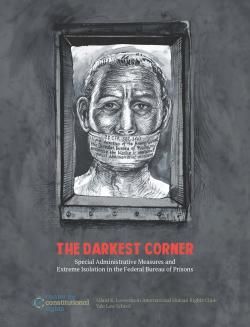Donald Trump has rightly drawn condemnation for his repeated threats to reinstate waterboarding and other forms of torture. But under a little-reported program, “Special Administrative Measures” (or “SAMs”), the U.S. government has quietly been subjecting detainees – including those who are still awaiting trial – to extreme and extended isolation that likely rises to the level of torture.
The story of Mohamed Warsame shows the extraordinary, coercive power that SAMs give federal prosecutors. Warsame, a Somali refugee who moved to the U.S. in 2002, was interrogated by the FBI because he briefly attended the same mosque as someone involved in the 9/11 attacks. When he rebuffed the FBI’s demands that he cooperate with them, he was arrested as a “material witness” to the 9/11 investigation and flown from his Minnesota home to a federal jail in New York. There, without a hearing and by unilateral order of the Attorney General, he was placed under SAMs.
Under SAMs, Warsame’s world shrank to the four corners of his cell. He spent twenty-two or more hours a day in his cell; “recreation” was simply moving, by himself, to an adjacent cell-size cage. The government forbade him from communicating with any other prisoners and censored news and other information. His wife and daughter could only visit after being cleared by the FBI, and even then, they could only speak to him via closely monitored closed circuit television. Otherwise, he could only reach them with one three-page letter each week or one fifteen-minute phone call each month. Even communications with his attorneys could be subject to government monitoring.
Once placed under SAMs, there was no clear path out. The Attorney General has unilateral authority to impose and renew SAMs. No court reviews the order, there is no hearing, and the prisoner generally receives no meaningful reason as to why he has been placed under SAMs. This lack of information, along with obstacles that SAMs restrictions create for lawyers communicating with their clients, makes it incredibly difficult for prisoners to challenge their SAMs placement through administrative procedures or in court.
Warsame filed five motions to make his conditions less isolating. The government opposed each motion, claiming Warsame’s communications posed a threat to national security. Then, after five and a half years, the government offered Warsame a plea deal of a shortened prison sentence followed by immediate deportation if he pleaded guilty. The implication was clear: cooperate or continue suffering under SAMs. Having lived in complete isolation for nearly half a decade, Warsame accepted. At his sentencing, the judge – who had denied the repeated requests to end Warsame’s isolation – remarked that he had “seen nothing in the record or the last five years of proceedings demonstrating that Warsame poses an immediate danger.”
What Warsame endured in federal custody mirrors – and in many ways was worse than – isolation units in state prisons around the country. The dangers of long-term isolation are well-documented and have inspired a national movement to “stop solitary.” How can it be that the federal government’s own program has largely escaped scrutiny?
A critical difference is that SAMs categorically bar prisoners from communicating with journalists, and those few people allowed contact with the SAMs prisoner risk criminal prosecution if they repeat any information about the prisoner or his conditions. The government has refused to release information of its own accord, routinely denying Freedom of Information Act (“FOIA”) requests concerning SAMs. Until now, the government has managed to suppress information about its use of these restrictive measures.
[caption align="left"] [/caption]
[/caption]On September 28, 2017, the Allard K. Lowenstein International Human Rights Clinic at Yale Law School and the Center for Constitutional Rights released a report that sheds some light into this darkest corner of the American penal system. That report is the conclusion of a two-year investigation into SAMs. The report primarily relies on interviews with attorneys who have represented prisoners under SAMs and documents obtained through FOIA by Human Rights Watch in collaboration with Columbia Law School’s Human Rights Institute and Yale Law School’s Media Freedom and Information Access Clinic, after years of litigation with the Bureau of Prisons and Department of Justice. Because of the SAMs, we were not able to speak with those most impacted by these measures—the prisoners themselves.
Our investigation reveals several deeply troubling aspects of SAMs. First, the conditions of confinement are dangerous. As numerous studies have demonstrated, long-term solitary confinement causes irreparable mental and physical harm. These studies prompted the U.N. Special Rapporteur on Torture to declare that prolonged isolation for more than fifteen days is cruel, inhuman, and degrading treatment and may constitute torture.
Second, the government imposes SAMs on some defendants before trial, while they are presumed innocent. Warsame spent five and a half years under SAMs while he was awaiting trial. We found similar instances of the government recommending lifting SAMs shortly after the defendant accepted a plea deal. That timing suggests that the government has used SAMs to coerce pre-trial detainees into pleading guilty or becoming government witnesses. The use of solitary to extract information constitutes torture and is barred by the U.S. Constitution as well as the United States’ obligations under the Convention Against Torture.
Third, the report reveals that, like other “counter-terrorism” measures implemented in the wake of 9/11, the government primarily imposes SAMs on Muslims. Among the forty individuals we identified as having been subjected to SAMs, thirty were Muslim—that is, 75 percent. In contrast, only six percent of the total federal prison population identifies as Muslim. This discrimination shows why it is so dangerous for the Attorney General to have unilateral discretion to determine when and upon whom to impose the harshest prison conditions in the United States.
Taking solitary confinement to another level, Special Administrative Measures impose torturous conditions that no human being should have to suffer—and they must end.

